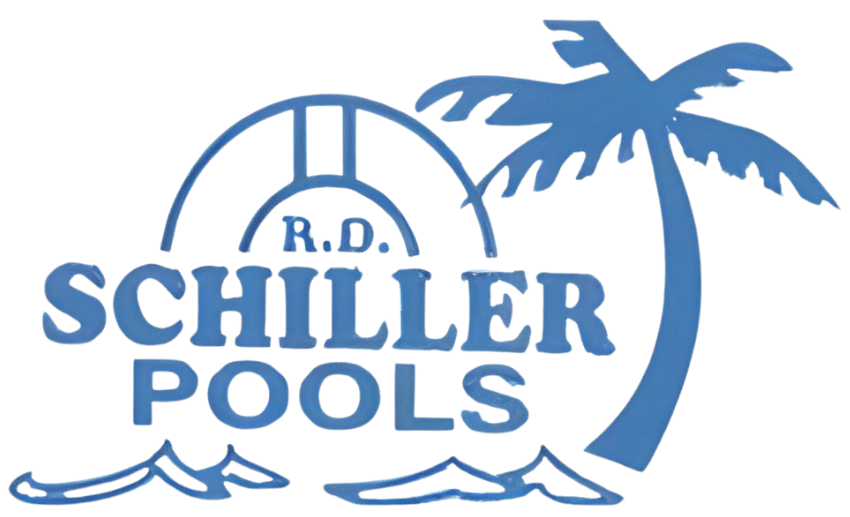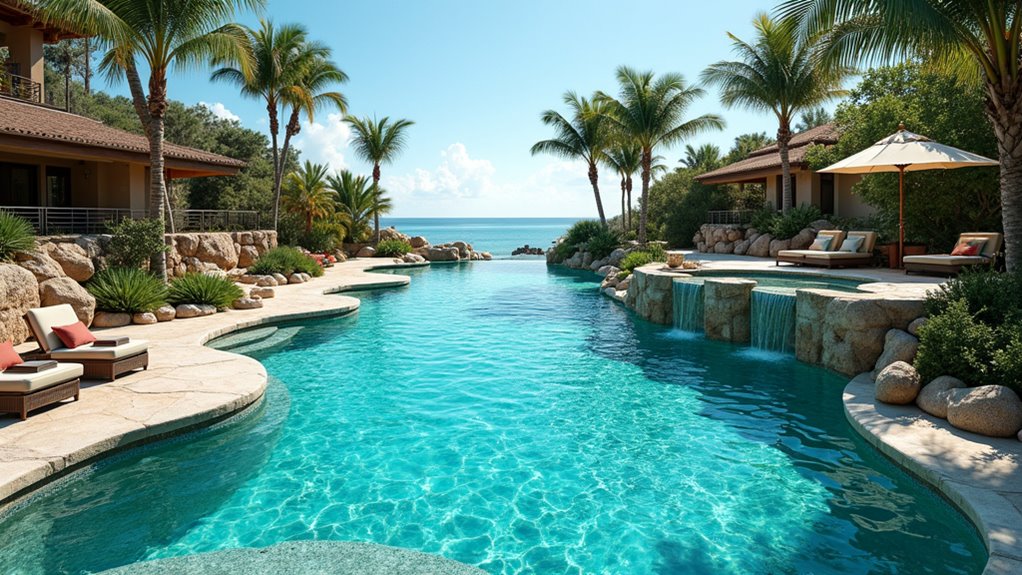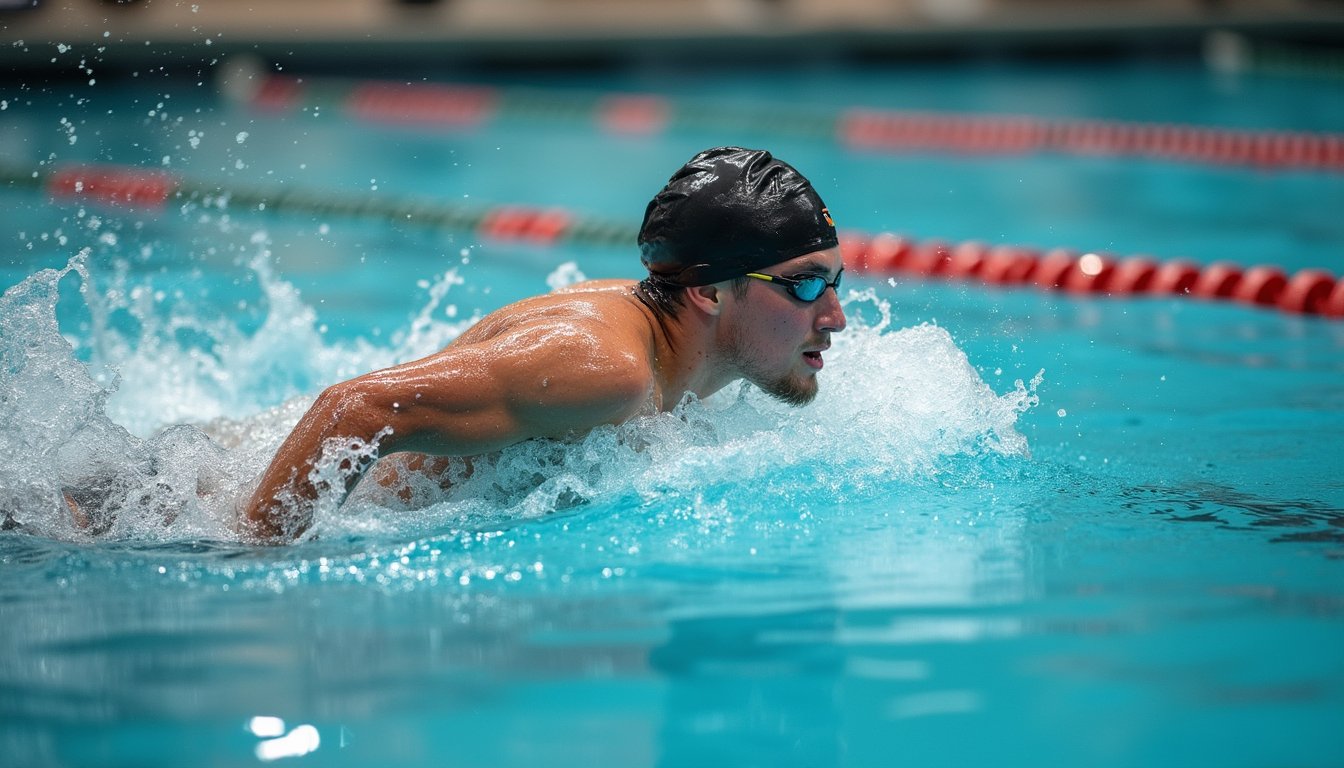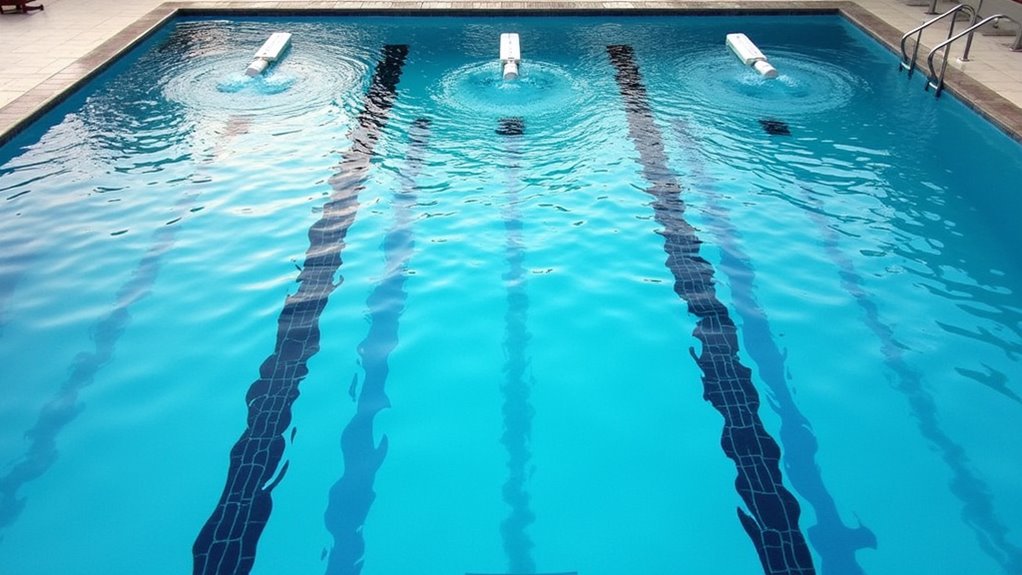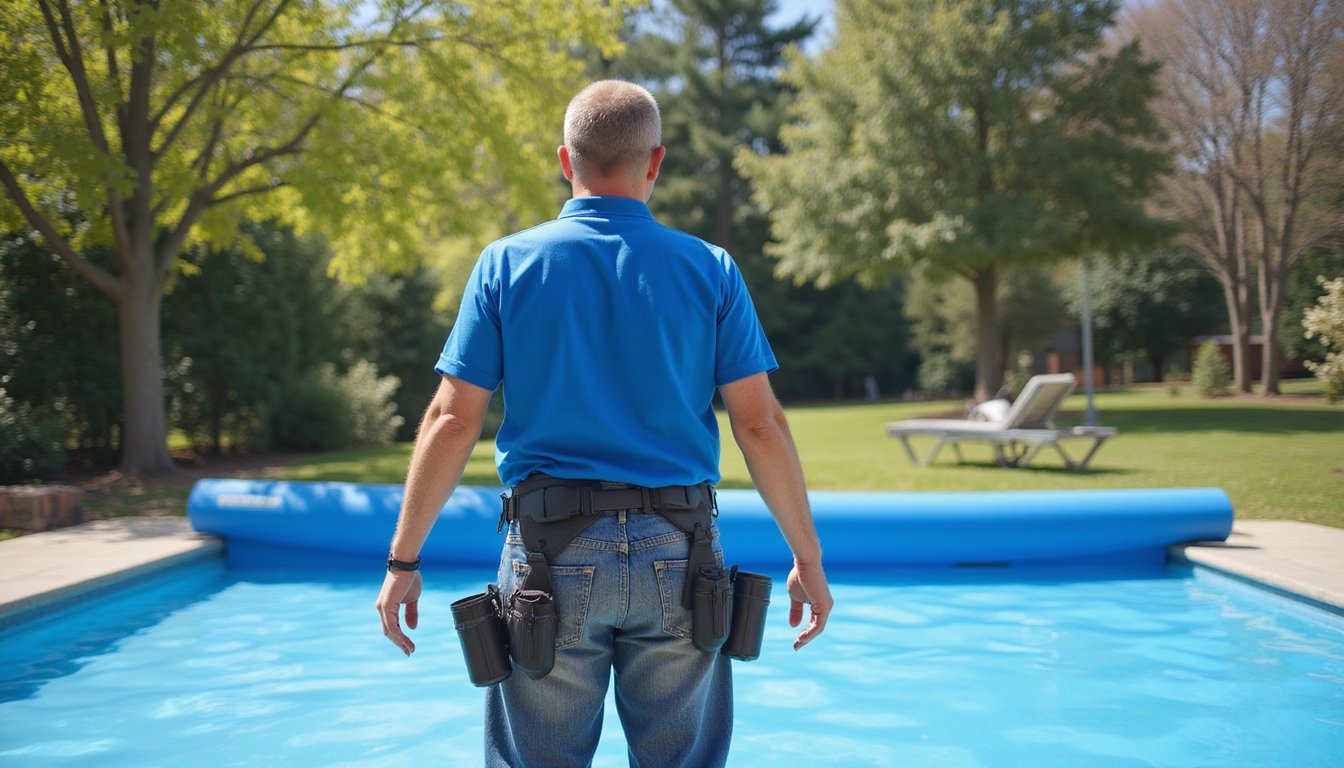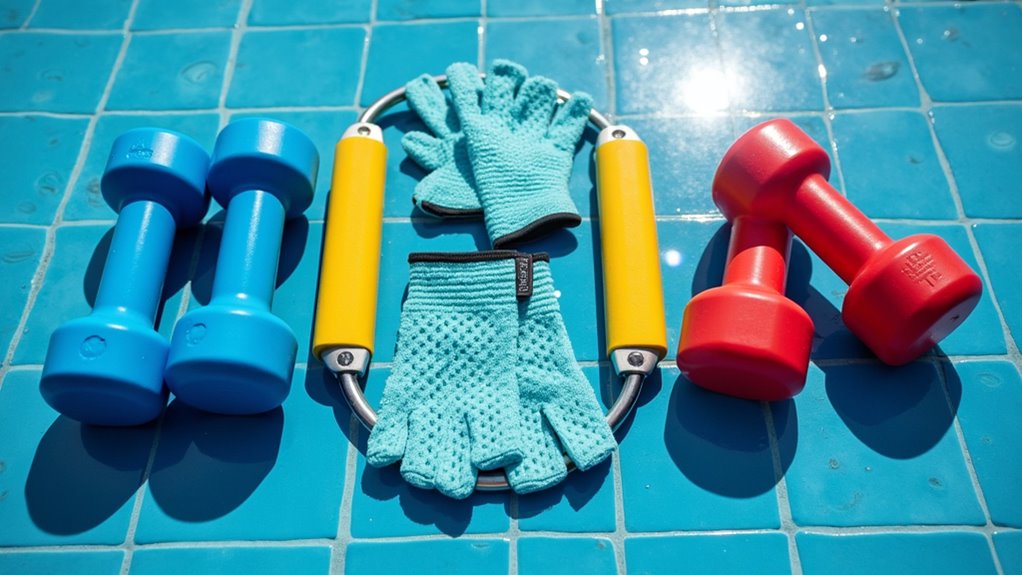Resistance pools allow you to optimize both cardiovascular and muscular development through adjustable current settings and variable resistance training. You’ll engage multiple muscle groups while minimizing joint stress, making it ideal for high-intensity interval training and progressive overload protocols. Start with 30-40% max flow to master proper form, then advance to higher intensities of 60-85% for strength and power development. The systematic progression of current speeds and resistance levels opens up advanced training possibilities for peak athletic performance.
Maximizing Cardiovascular Performance Through Variable Currents

While traditional swimming offers significant cardiovascular benefits, variable current training elevates your heart’s performance to new levels of efficiency. By engaging in continuous swim performance against adjustable resistance, you’ll challenge your cardiovascular system through precisely controlled intensities that adapt to your fitness level. High-intensity interval swimming has demonstrated superior cardiovascular endurance improvements compared to other aquatic exercises.
Variable current cycling allows you to progressively increase workload on your heart and lungs, maximizing oxygen delivery throughout your body. Customizable settings make it simple to gradually increase resistance as your stamina improves. You’ll experience heightened stroke volume and cardiac output as your body adapts to the dynamic resistance. The low-impact cardio environment makes it an ideal choice for athletes of all fitness levels seeking intensive training without joint stress. This targeted approach to cardiovascular conditioning has shown to reduce mortality risk by up to 41% compared to non-swimmers, particularly in cases of heart disease and stroke. For those recovering from cardiac conditions, the controlled environment enables safe, effective rehabilitation while maintaining ideal heart rate zones.
Building Muscle Mass With Water Resistance Training
Unlike traditional weight training, water resistance provides a specially adaptive environment for building muscle mass through variable load mechanics. You’ll experience progressive overload training strategies as movement speed directly correlates with resistance intensity, forcing both concentric and eccentric muscle contractions. Since hydrostatic training offers a low-impact workout, it’s particularly beneficial for those with joint sensitivities.
Water’s hydrostatic properties engage multiple muscle fiber adaptation mechanisms simultaneously, with research showing up to 17.1% increases in Type II fiber cross-sectional area. Your muscles adapt through enhanced myonuclear recruitment, potentially increasing total fiber count by 26.1% under ideal conditions. For maximum hypertrophy, you’ll want to combine concurrent resistance training with power training methodologies while avoiding cold water immersion post-exercise, as this can attenuate muscle gains. Research demonstrates that active recovery methods produce superior strength gains compared to cold water immersion therapy. The omnidirectional resistance creates a unique training stimulus that challenges muscles differently than gravity-based exercises. Studies indicate that matrix remodeling proteins are better expressed during active recovery compared to cold water immersion, supporting optimal muscle repair and growth.
Advanced Interval Training Techniques in Endless Pools

Advanced interval training in endless pools kicks up your cardiovascular conditioning through precisely controlled resistance and adjustable workout intensities. You’ll maximize technique mastery while leveraging customized pool dynamics to improve your performance metrics. Low injury risk makes endless pool training an ideal choice for high-intensity workouts without compromising joint health.
- Execute Tabata protocols with 20-second maximum efforts against adjustable current
- Implement race-pace sets using precise speed controls for consistent pacing
- Utilize resistance equipment like hand paddles to amplify water resistance
- Perform HIIT sequences with varied current speeds for progressive overload
- Incorporate six-directional movement patterns for thorough conditioning
Your body adapts quickly to the controlled aquatic environment, allowing you to fine-tune workout intensity based on real-time performance feedback. The endless pool’s adjustable current lets you maintain ideal form while progressively increasing workout difficulty, ensuring consistent advancement in both cardiovascular capacity and muscular endurance.
Customizing Current Settings for Peak Performance
To optimize your training efficiency, you’ll want to customize the pool’s current settings based on your specific performance goals and current fitness level. You can progressively increase water resistance to challenge your muscular strength and cardiovascular endurance while maintaining proper form and technique. The ability to precisely control current speeds allows you to create targeted training zones that effectively improve your swimming power output and stamina without overstraining your joints and muscles. Variable speed controls allow you to adjust the intensity at the touch of a button for precise workout customization. Incorporating a swim tether system enables consistent resistance training while swimming in place, making the most of limited pool space. Regular practice focusing on bilateral breathing helps maintain proper balance and efficiency throughout intense resistance training sessions.
Adjusting Resistance for Goals
When customizing resistance settings for aquatic training, your primary focus should center on matching the water’s adaptive properties with your specific performance goals. You’ll maximize muscle activation patterns through precise control of water resistance levels, while achieving superior metabolic conditioning benefits from the adaptive resistance properties. The water’s omnidirectional resistance provides comprehensive loading of movement patterns for optimal athletic development.
Begin with lower resistance settings to establish proper form and movement patterns
Increase current speeds progressively as strength and endurance improve
Target specific energy systems by adjusting resistance for interval training
Utilize variable resistance settings to challenge different muscle groups
Monitor performance metrics to adjust resistance levels systematically
Modern durable nylon tethers provide enhanced stability for maintaining consistent resistance levels throughout your workout. For rehabilitation or performance enhancement, you can fine-tune the resistance to match your exact needs. The SwimEx EDGE system lets you program specific current speeds for each phase of your workout, ensuring perfect adaptation while maintaining proper biomechanics throughout your training sessions. The touchscreen tablet interface allows users to create custom workouts and access pre-programmed training routines.
Progressive Current Training Methods
Mastering progressive current training requires systematic customization of water flow settings to achieve peak athletic performance. You’ll optimize results by implementing complex current configurations that match your specific training goals and current fitness level.
Start with 30-45 second work intervals using barefoot resistance, then progress to equipment-enhanced protocols including fins and resistance boots over a 16-week cycle. Research shows that swimming performance improves when resistance training methods are specific to swimming movements. You’ll find that combining assisted and resisted training methods yields superior gains compared to single-direction resistance work. The patented turbine design automatically positions your body while swimming, allowing you to focus on proper form and technique.
Adjust current intensities to challenge your maximum ability while maintaining proper stroke mechanics. Utilize optimized resistance programming through systematic progression of current speeds, ensuring consistent performance improvements across multiple training zones.
Speed-Based Interval Protocols
Building on the foundation of progressive current training, speed-based interval protocols offer advanced swimmers targeted methods for enhancing performance through precise current calibration. You’ll maximize your metabolic thresholds by alternating between high-intensity sprints and strategic recovery periods, pushing your anaerobic capacity to new levels.
- Set current speed at 85-90% of your maximum sprint pace for initial intervals
- Monitor heart rate response to maintain ideal training zones
- Adjust rest periods between 20-60 seconds based on training goals
- Implement automatic rest penalties when missing target speeds
- Progress by gradually increasing current resistance while maintaining form
Your performance metrics will determine current adjustments, with lactate threshold serving as a key indicator for intensity calibration. When you can’t maintain proper technique, reduce current speed rather than compromising form, ensuring effective adaptation while preventing technique degradation.
Combining Strength and Endurance Training Methods
To optimize your aquatic training potential, you’ll need to integrate resistance-based interval sets using parachutes and paddles with strategic rest periods of 20-30 seconds between 8x50m efforts. You can progressively increase current load intensity by incorporating wall-based power movements and deep-water vertical training while maintaining proper form through each phase. Multi-muscle circuit workouts, rotating between different pool zones and equipment stations, will simultaneously develop your strength and cardiovascular endurance while reducing joint stress through water’s natural buoyancy.
Interval Training With Resistance
When combining strength and endurance training in an aquatic environment, your body experiences unique adaptations through the water’s natural resistance properties. By integrating high resistance intervals with strategic recovery periods, you’ll optimize both muscular engagement and cardiovascular benefits. Your muscles work against constant resistance while maintaining proper form through buoyancy support.
- Ultra Short Race Pace Training maintains specific intensities through brief work periods
- Water resistance increases caloric expenditure during high intensity recovery intervals
- Musculoskeletal stress remains minimal due to water’s natural cushioning effect
- Cardiovascular adaptation occurs through varied work-to-rest ratios
- Equipment modifications accommodate different fitness levels during resistance work
Structure your intervals with a proper 5-10 minute warm-up, followed by alternating work-rest periods. Your recovery intervals should match your fitness level while maintaining sufficient intensity for adaptation. This combined approach enhances strength gains while improving endurance capacity through water’s natural resistance properties.
Progressive Current Load Methods
Progressive current load training revolutionizes aquatic fitness by combining strength and endurance development through adjustable water resistance systems. You’ll experience customized interval pacing through hydrodrive technology that generates smooth, adjustable currents reaching competitive swimming speeds of 1:14/100m.
| Load Phase | Current Intensity | Training Focus |
|---|---|---|
| Beginner | 30-40% max flow | Form/Technique |
| Novice | 45-55% max flow | Base Endurance |
| Intermediate | 60-70% max flow | Strength/Power |
| Advanced | 75-85% max flow | Speed/Power |
| Elite | 85-100% max flow | Race Pace |
Your progressive loading challenges follow systematic 2.5-5% increments, similar to traditional strength training principles. This omnidirectional resistance approach engages your entire kinetic chain while providing low-impact loading that simultaneously develops strength, mobility, and neurological efficiency through complete movement patterns.
Multi-Muscle Circuit Workouts
Building upon the principles of progressive current training, multi-muscle circuit workouts in aquatic environments maximize both strength and endurance adaptations through systematic exercise sequencing. The water’s natural resistance, providing 12-15 times more challenge than air, facilitates heightened muscle synergy activation while supporting integrated joint mobility through reduced gravitational load.
- Target 50-70% of functional capacity for effective training zone
- Alternate between 2-3 minute stations to maintain continuous movement patterns
- Increase movement speed progressively to create greater turbulence resistance
- Focus on multi-directional movements to engage core stabilization
- Utilize buoyancy advantages for expanded range of motion exercises
You’ll achieve simultaneous cardiovascular and strength improvements while reducing impact stress on joints. This efficient training method accelerates recovery between sets while maintaining high-intensity muscle engagement, delivering superior results in shortened training durations compared to traditional land-based circuits.
Monitoring Form and Technique With Mirror Systems
A strategically positioned mirror system transforms your pool into a self-monitoring training environment, enabling real-time analysis of swimming technique and form. You’ll benefit from on-the-fly form corrections as you observe your body alignment, stroke mechanics, and breathing patterns through polished stainless steel reflective surfaces.
The 2′ x 3′ floor mirrors, secured with suction cup mounts, provide real-time visual feedback without requiring permanent pool modifications. You’re able to monitor body roll, hand entry mechanics, and limb positioning while maintaining proper alignment to reduce drag. This self-awareness development helps you refine your technique through continuous observation, particularly during resistance training sessions.
The system’s durability features, including corrosion-resistant materials and pH-balanced construction, guarantee reliable performance across different aquatic exercise routines, from basic strokes to advanced competitive training.
High-Intensity Aquatic Workouts for Elite Athletes

You’ll optimize power output through aquatic resistance by executing precise stroke mechanics during high-velocity sprint intervals, where water’s natural viscosity creates progressive overload as you accelerate. Your speed development relies on mastering the Tabata protocol‘s twenty-second maximum-effort bursts followed by ten-second recovery periods, systematically targeting different stroke patterns across multiple energy systems. To enhance race-day performance, you must integrate cross-pattern movements and self-regulated intensity training while maintaining proper body positioning through each phase of your aquatic workout.
Maximum Power Through Water
Through novel aquatic training methods, elite athletes can now harness water’s omnidirectional resistance to optimize power output and cardiovascular gains. Your metabolic conditioning substantially improves as water provides resistance in all planes of motion, enhancing your metabolic efficiency through integrated movement patterns.
- Execute underwater sprints to develop full-body power generation
- Perform rotational movements to strengthen core-to-extremity force transfer
- Utilize jumping exercises for explosive power development
- Incorporate throwing motions for upper body power enhancement
- Add trunk dissociation drills for improved movement efficiency
You’ll experience measurable improvements in VO2 max, with studies showing increases from 45.3 to 49.7 mL/Kg/min. Your rate of force development and power-to-bodyweight ratio will improve while maintaining training continuity. This method allows you to train at high intensities without risking impact-related injuries, making it ideal for both performance augmentation and rehabilitation protocols.
Elite Speed Training Methods
When elite athletes require maximal speed development, high-intensity aquatic workouts provide a scientifically-proven training environment that maximizes neuromuscular adaptations while minimizing joint stress. You’ll enhance your training through aquatic plyometric training and underwater treadmill workouts in 26-28°C water temperatures.
| Training Method | Primary Benefit |
|---|---|
| Deep-Water Running | Back-Half Power Development |
| Silent Swimming | Stroke Refinement |
| Resistance Bands | Progressive Overload |
| Underwater Sprints | Explosive Power |
Your speed development protocol should incorporate deep-water running with the knee-up/foot-down technique, eliminating foreleg reach for best water resistance. You’ll need to focus on proper arm mechanics, pulling your elbows straight back to your imaginary hip pocket. Progressive resistance training using torso harnesses boosts your power output while maintaining precise movement patterns through water’s natural viscosity.
Perfecting Race-Day Performance
Three key elements of race-day performance optimization emerge from high-intensity aquatic training: current adaptation, power development, and movement integration. You’ll refine your pacing strategy development through SwimEx’s 99 resistance levels, simulating varied race conditions while maintaining precise technique refinement.
- Alternate high-intensity sprints with moderate recovery intervals to build speed-endurance
- Execute breathing and sighting drills against adjustable currents to master open-water navigation
- Perform FACC movements for 17.8% greater power gains through accommodated resistance
- Integrate swim-to-bike brick workouts for seamless race changeovers
- Maintain joint health while achieving peak performance through water-supported training
The analytical feedback from NLAC Swim Smart metrics enables you to track improvements in speed, power, and movement efficiency. This data-driven approach optimizes your training progression while minimizing injury risk through reduced joint stress.
Targeting Specific Muscle Groups in Resistance Pools
Resistance pools offer unique advantages for targeting specific muscle groups through omnidirectional water resistance. You’ll engage stabilizer muscle development more effectively than traditional gym workouts, as water provides constant resistance in all directions. When targeting upper body muscles, the breaststroke and butterfly motions specifically strengthen your latissimus dorsi, pectorals, and rhomboids.
For muscular endurance improvements, focus on continuous movement patterns that engage multiple muscle groups simultaneously. Your core stabilizers will naturally activate to maintain proper form against water resistance. The pool environment creates ideal conditions for developing strength throughout entire movement chains, rather than isolating individual muscles. This thorough approach guarantees balanced muscle development while reducing the risk of overuse injuries common in traditional resistance training.
Advanced Recovery and Rehabilitation Protocols
Advanced aquatic rehabilitation protocols incorporate five essential therapeutic methods to maximize post-surgical and injury recovery outcomes. You’ll progress through specialized aquatic rehabilitation techniques that combine the Halliwick and Burdenko methods with targeted resistance training. These advanced postoperative protocols utilize chest-deep water for ideal buoyancy while maintaining precise control over weight-bearing progression.
- Water-proof dressing enables therapy initiation at 2 weeks post-surgery
- Three-part sessions include warm-up, strength training, and core work
- Pain-free motion maintenance prevents compensation patterns
- Progressive depth adjustments allow controlled load increases
- Multi-planar activities improve rehabilitation effectiveness
Your recovery program will integrate aqua jogging with floating vests and resistance bands while monitoring pain levels. As you advance, you’ll incorporate phase-specific yardage progressions and stroke mechanic drills, limiting daily increases to 5% to prevent symptom exacerbation during rehabilitation.
Incorporating Cross-Training Elements in Pool Workouts
While traditional pool workouts focus primarily on swimming, incorporating diverse cross-training elements can greatly improve your rehabilitation outcomes and athletic performance. You’ll benefit from pool based mobility enhancements through water’s natural resistance, which enables customized movement patterns suited to your fitness level. Integrate aquatic boxing, yoga, and strength training to engage multiple muscle groups while minimizing joint stress.
| Activity Type | Benefits | Implementation |
|---|---|---|
| Aquatic Boxing | Cardiovascular fitness | HIIT intervals |
| Water Yoga | Flexibility, mobility | Slow, controlled movements |
| Resistance Training | Strength building | Variable speed exercises |
| Plyometrics | Power development | Explosive movements |
Your cross-training program should include water running, kickboard exercises, and dynamic stretching routines. These elements work together to expand your range of motion while providing extensive strength and cardiovascular benefits in a low-impact environment.
Frequently Asked Questions
How Long Should Beginners Wait Between Resistance Pool Training Sessions?
You’ll need to wait 24-48 hours between resistance pool training sessions to allow proper recovery time and prevent excessive muscle fatigue. Your body requires this rest period to repair muscle fibers and adapt to the training stimulus. If you’re performing high-intensity resistance exercises, gravitate toward the longer 48-hour recovery window. Monitor how your muscles feel, persistent soreness signals you need more rest between sessions.
Can Resistance Pools Help With Weight Loss Compared to Regular Pools?
Yes, resistance pools offer superior weight loss benefits compared to regular pools. You’ll experience an increased metabolic rate due to the added resistance of specialized jets and currents, burning more calories than standard swimming. The reduced joint impact allows you to exercise longer and more intensely, while the variable resistance settings help target specific muscle groups. You’ll also maintain higher heart rates throughout your workout, leading to greater fat burning potential.
What Type of Swimwear Is Best for Resistance Pool Training?
You’ll want to choose swimwear with 76% polyester + 24% Spandex blend for ideal resistance training performance. This composition adapts to pool temperature considerations while maintaining structural integrity. For cooler resistance pools, consider wetsuit material selection in 2mm thickness to maintain core temperature. Look for double-layer construction with Super Proback cut and reinforced seams to enhance drag benefits while ensuring proper muscle engagement during your workout.
Are Resistance Pools Safe to Use Alone Without Supervision?
You shouldn’t use resistance pools alone, even if you’re an experienced swimmer. Always follow proper safety protocols by having a training partner or qualified supervisor present. While resistance pools are generally safer than traditional pools due to their shallow depth, unexpected muscle fatigue or cramps can still occur. Start with gradual workout progressions and guarantee you’ve mastered basic movements before attempting advanced exercises. It’s better to prioritize safety over convenience.
How Much Space Is Typically Needed to Install a Resistance Pool?
You’ll need approximately 3 x 5.2 meters of total space for a standard resistance pool installation. The ideal pool dimensions typically range from 2.1-6 meters long and 1.8-2.7 meters wide. You’ll want to allow at least 0.9 meters of decking space around the pool’s perimeter for safe access. The appropriate pool depth varies based on your needs, but you must verify your installation site can support 200-260 pounds per square foot of loading capacity.
